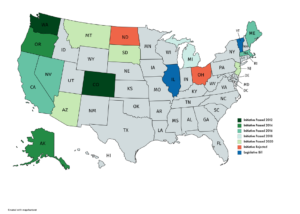Election day 2020 was another big moment for drug policy reform in the US as voters across diverse states rejected the status quo and endorsed liberalizing drug laws. Arizona, Montana, New Jersey and South Dakota legalized marijuana for recreational purposes as the news proclaimed voters had “just said no to America’s war on drugs,” calling it “a banner year for drug decriminalization.”
That election day brought significant wins for drug policy reform is not new. Beginning in 2012 with Colorado and Washington state, 13 out of the 15 states that have legalized recreational cannabis thus far have done so through ballot measures.[1] In 2014, Alaska and Oregon followed suit along with Nevada, Massachusetts, Maine and California in 2016 and Michigan in 2018.
With elected politicians still hesitant to touch an issue long considered politically toxic, ballot initiatives have been the predominant means of state-level cannabis reforms. Putting marijuana legalization to the voters has allowed strong public support to translate into policy outcomes.
However, these ballot initiatives may not be the be-all and end-all as not all states permit such initiative processes nor have all recreational ballot initiatives been successful in the past decade: Voters in California (2010), Oregon (2012), Ohio (2015), Arizona(2016) and North Dakota (2018) rejected marijuana legalization.

Change in 2020
What was new about drug policy reform on the ballot in 2020 was that voters in conservative states also embraced recreational cannabis, support which had previously been limited to only medicinal marijuana. Prior to 2020, marijuana legalization traditionally won in “blue” states carried by Democratic candidates for presidential and Senate races. Only the “red” state of Alaska had voted in favor of recreational cannabis.[2] That voters in both South Dakota and Montana approved marijuana legalization is both surprising and significant. Voters in North Dakota in a 2018 mid-term election overwhelmingly rejected recreational cannabis regulation. Since the Dakotas share many socio-economic, demographic and ideological characteristics, the vote this round in South Dakota is especially noteworthy.
In fact, legal marijuana outperformed the winning presidential candidate in three out of four states in which it was on the 2020 ballot. In New Jersey, legal pot was approved by 66.9% to Biden’s 57.3% vote share. In Montana, Trump’s 56.7% of the vote was narrowly under the 56.9% in favor of legalization and in Arizona cannabis approval leads both Trump and Biden by 10%. Only in South Dakota did Donald Trump gain more votes than legal cannabis, with 61.8% to 54.8%.[3]
| Year | State | Outcome | Yes | No | Difference |
| 2010 | California | L | 46.5% | 53.50% | -7% |
| 2012 | Oregon | L | 46.58% | 53.42% | -6.84% |
| 2012 | Washington | W | 55.7%% | 44.30% | 11.4% |
| 2012 | Colorado | W | 55.32% | 44.68% | 10.64% |
| 2014 | Oregon | W | 56.11% | 43.89% | 12.22% |
| 2014 | Alaska | W | 53.23% | 46.77% | 6.46% |
| 2015 | Ohio | L | 65.35% | 63.65% | -27.30% |
| 2016 | Arizona | L | 48.68% | 51.32% | -2.64% |
| 2016 | California | W | 57.13% | 42.87% | 14.26% |
| 2016 | Maine | W | 50.26% | 49.74% | 0.52% |
| 2016 | Massachussets | W | 53.66% | 46.34% | 7.32% |
| 2016 | Nevada | W | 54.47% | 45.53% | 8.94% |
| 2018 | North Dakota | L | 40.55% | 59.54% | -18.9% |
| 2018 | Michigan | W | 55.89% | 44.11% | 11.78% |
| 2020 | South Dakota | W | 54.18% | 45.82% | 8.36% |
| 2020 | Arizona | W | 59.96% | 40.04% | 19.92% |
| 2020 | Montana | W | 56.89% | 43.11% | 13.78% |
| 2020 | New Jersey | W | 66.88% | 33.12% | 33.76% |
Note: Information from Ballotpedia, not all 2020 results are final
The above table shows every instance that recreational marijuana legalization has been on a state ballot during the past decade, usually concurrent with presidential or mid-term elections.[4] With significant variation in the ways such ballot initiatives are crafted and funded as well as the makeup of the electorate in midterm vs. presidential elections, it is hard to draw conclusions about the average differences or changes in votes between states in the table above.
What is noteworthy, though, are changes over time in the same state. Arizona voters rejected a marijuana legalization ballot initiative in 2016 by 2.64% and approved one in 2020 with a 19.92% margin. In California, Proposition 19 lost in 2010 by 7%, but in 2016 Proposition 64 won by 14.26%. And, in Oregon the vote swung by 19.06% between 2012 and 2014.
What comes next?
The 2020 election has reinforced several preexisting trends in marijuana legalization and suggests new directions for the continuing demand for drug policy reform.
First, marijuana legalization is remarkably popular across the US: it has become a winning issue even in “red” states, has actually outperformed the Democratic candidate 10 out of 13 times a successful cannabis initiative has been on the ballot,[5] and has substantially grown in popularity within the same state wherever it was voted on twice over the past decade. The increasing, and increasingly bi-partisan, support for cannabis reform on the state level might be a signal to beltway policymakers to end federal-level prohibition of cannabis from seed to smoke.
Second, recreational cannabis reform is uniquely popular in the US when compared to peer countries. Legal marijuana succeeded in socially conservative Montana and South Dakota whilst narrowly failing in a referendum in progressive New Zealand just two-and-a-half weeks prior. That public support for recreational marijuana legalization has steadily increased in the past decade is well-established, yet how much stronger public support for legal access is in the US than almost anywhere else remains underappreciated.
Last but not least, voter-driven drug policy reform in the US is no longer limited to medicinal or recreational marijuana. On election day 2020, voters embraced drug liberalization beyond cannabis. Voters in Oregon decriminalized all drugs, which means possession of small amounts of drugs for personal consumption will no longer incur criminal penalties. They also legalized the use of psylocibin, the psychoactive substance in so-called “magic mushrooms” for mental health treatment. With one of the trailblazing states of cannabis legalization liberalizing its drug laws regarding other substances, marijuana legalization might just prove to be a “gateway” drug policy reform (if not for actual drug use).
In sum, voters across the US have acted where politicians would not, making use of the ballot initiative process to reform drug policies. Over the past decade, Americans have voted for state-level legalization of recreational marijuana, and, in 2020, for legalizing and decriminalizing other substances. With recreational cannabis reform enjoying public support even in “red” states, it might be high time for the incoming Biden administration to deal with increasingly unpopular and anachronistic federal drug prohibitions.
[1] Excluding Washington DC which passed an initiative in 2014 as well.
[2] Alaska is atypical when it comes to cannabis as home cultivation and non-commercial exchange have been legal since an Alaskan Supreme Court decision in 1975.
[3] Presidential Election results are from the New York Times. At the time of writing some of these results are provisional and counts have not been finalized.
[4] The outlier was Ohio in 2015, which was further exceptional in having a particularly poorly drafted initiative, disavowed even by pro-reform actors.
[5] Recreational cannabis ballot initiatives gained more votes than either the Democratic presidential or senatorial candidates in Colorado (2012), Oregon (2014), Alaska (2014), Maine (2016), Nevada (2016), Michigan (2018), South Dakota (2020), Arizona (2020), Montana (2020) and New Jersey (2020).


